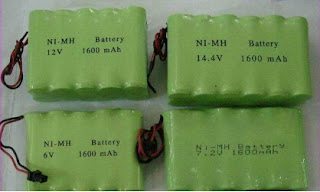NIMH or Li-Po Battery for My RC Car
Many new RC car beginners get confused about what kind of batteries they should choose for their RC car NIMH or Ni-Po battery? What are the differences between them? As you may hear some questions like “ What kind of RC car batteries should I buy? “ “Can I use LIPO battery for my RC car?”“What are the differences between 6s 7.2v NIMH battery and 2s 7.4v Lipo battery?” So let’s take these batteries as an example and make a comparison between them in several ways.NIMH, Nickel Metal Hydride, serves as a replacement for NiCd as it has only mild toxic metals and provides higher specific energy.
LIPO, lithium polymer battery, is a rechargeable battery of lithium-ion technology in a pouch format.
Let’s compare these batteries in the following aspects:
Price:
NiMH:It is cheaper than the Lipo battery. You may find the price of an 7.4V Lipo battery could afford two 7.2V NiMH batteries for your rc car.
Lipo: It is more expensive, but as the production scale of Lipo battery gets bigger, the production cost will get lower and lower and so as the price.
Voltage
NiMH: It’s nominal voltage is 1.2v per cell. As we can see from the picture, the common voltages for NiMH battery are 6v, 7.2v, 12v, 14.4v.
Lipo: It’s nominal voltage is 3.7v per cell. So we usually find Lipo batteries in 7.4V, 11.1V, 14.8V, 18.5V, 22.2V.
Weight/size
NiMH: 7.2v NiMH batteries are heavier than 7.4V Lipo batteries for the same capacity. And it’s bigger than the Lipo one.
Lipo: Lighter and smaller than the NiMH one, this makes a great difference for rc cars . That’s why Lipo batteries are getting more and more popular in the RC cars.
Memory effect
NIMH: It has the memory effect. It is commonly believed that when rechargeable batteries are not fully discharged between charge cycles that they remember the shortened cycle and are thus reduced in capacity. Which is also called “voltage depression”.
Lipo: Do not have the memory effect. So the full capacity of the Lipo will always larger than the NIMH one after being used for weeks.
Charge and discharge:
NIMH: It is not that dangerous if it is over discharged or over charged. But over charging or over-discharging will shorten the life span of the NiMH batteries.
Lipo: Can never be over discharged or over charged. Or it will damage the battery, explode, or even get your rc car on fire.
Battery charger
NIMH&Lipo: You have to choose the correct battery chargers for them or use charger that can both charge NiMH and Lipo batteries.
Power&Capacity
NIMH:A nimh battery has a consistently less power as you run it down.
Lipo: Lipo batteries will provide longer and quality run time for its larger capacity and C rates.
To make a conclusion, lipo batteries are better choice for RC cars.










